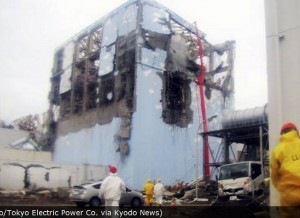Last year’s tsunami debris; from nuclear and chemical to flat morbid
by Jen Matteis
 A year has passed since the Fukushima disaster, but one aftereffect — a floating debris field the size of California — is just beginning to arrive on the West Coast.
A year has passed since the Fukushima disaster, but one aftereffect — a floating debris field the size of California — is just beginning to arrive on the West Coast.
The magnitude 9.0 earthquake and ensuing tsunami led to the biggest nuclear disaster since Chernobyl, killed almost 20,000 individuals, and washed entire towns into the Pacific Ocean.
As for the millions of tons of debris heading for our beaches, the obvious concern is whether or not it’s radioactive. During the meltdowns at the Fukushima nuclear plant, radioactive material was vented into the atmosphere and discharged into the ocean, settling on the ocean-borne wreckage.
According to Kathryn Higley, chair of the Department of Nuclear Engineering and Radiation Health Physics at Oregon State University, “the radiation is not the concern.” She explained that rain and waves hitting the debris during its nearly 5,000-mile trip to the West Coast will have diluted the radiation, washing it off into the ocean.
“This material has been out in the weather for a year and the contaminants that could have been deposited on it are largely water-soluble,” she said. “You might be able to detect it because we have some really sophisticated detection equipment, but it’s not expected to be anything of consequence.”
The nuclear power plant’s meltdowns also happened several days after the tsunami, so most of the wreckage was swept out to sea before the radiation hit. Instead, long-ranging fish may be a bigger source of radiation.
“There are a few fish that travel very long distances, and you might see something in them,” Higley said.
 The debris may be dangerous for other reasons. Hazardous materials and industrial-strength chemicals might start showing up on beaches. Everything from a town, from the paint cans and solvents in the hardware stores to the pesticides and herbicides in the nurseries and agricultural stores, ended up in the ocean.
The debris may be dangerous for other reasons. Hazardous materials and industrial-strength chemicals might start showing up on beaches. Everything from a town, from the paint cans and solvents in the hardware stores to the pesticides and herbicides in the nurseries and agricultural stores, ended up in the ocean.
“This is debris from destruction of homes, industries, all along the coast. It will not necessarily be benign,” commented Higley.
Use common sense and consult local authorities if you find anything you think might be hazardous, such as sealed drums.
“Don’t pick it up,” warned Higley.
According to CNN, human body parts might also wash ashore, as more than 3,700 Japanese were never found. The debris should start arriving sometime this year, but it won’t be a novelty for long — it may take up to three years for us to see the end of it.
Do you have a story for The Advocate? Email editor@corvallisadvocate.com

